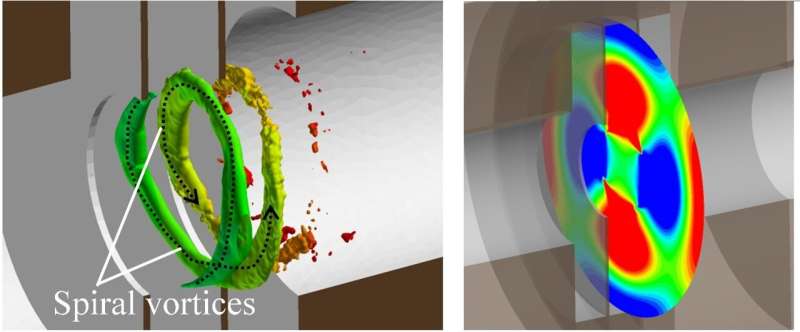This article has been reviewed according to Science X's editorial process and policies. Editors have highlighted the following attributes while ensuring the content's credibility:
fact-checked
peer-reviewed publication
trusted source
proofread
Understanding flow and sound through large-scale computations

In a research collaboration between the group of Professor Hiroshi Yokoyama of the Department of Mechanical Engineering and KOBE STEEL, LTD., flow, and acoustic fields in an expanding pipe with orifice plates were studied using a computational methodology developed by Prof. Yokoyama's group. The flow fields, including the various vortical structures and generated acoustic fields, were explained for the first time.
Expanding pipes with orifice plates are often used as silencers in fluid machinery. However, intense tonal sounds can be generated from the flow through these expanding pipes. Yet, the flow and sound in such complex configurations are not well understood.
To understand the mechanism of tonal sound from a flow through a circular expanding pipe with two orifice plates and the conditions for intense acoustic radiation, the flow, and acoustic fields were directly studied based on a large-scale computational methodology developed by Professor Yokoyama's group at the Toyohashi University of Technology in collaboration with KOBE STEEL, LTD.
The computational results show that tonal sound radiation occurs because of the collision of the vortices with the orifice plates or the downstream edge of the expanding pipe. The vortical structures were found to change with velocity and orifice radius, where spiral vortices, vortex rings, and arch-shaped vortices appeared. This change led to variations in the frequency and mode of the primary sound. The results were published in Physics of Fluids.
Based on the findings from this study, research, and development for the realization of a system with a low environmental cost, including fluid machinery, are planned in the future. During the development of the computational methodology, wind tunnel experiments are performed under various conditions, and the results are compared with those predicted to validate the computational methods.
Although the generation of various vortices, such as spiral vortices and the corresponding acoustic mode, is clarified, the basic mechanism for the generation of these vortices is not completely understood and requires further investigations in the future.
More information: Akitomo Fukuma et al, Fluid–acoustic interactions around an expanding pipe with orifice plates, Physics of Fluids (2024). DOI: 10.1063/5.0193029
Journal information: Physics of Fluids
Provided by Toyohashi University of Technology





















